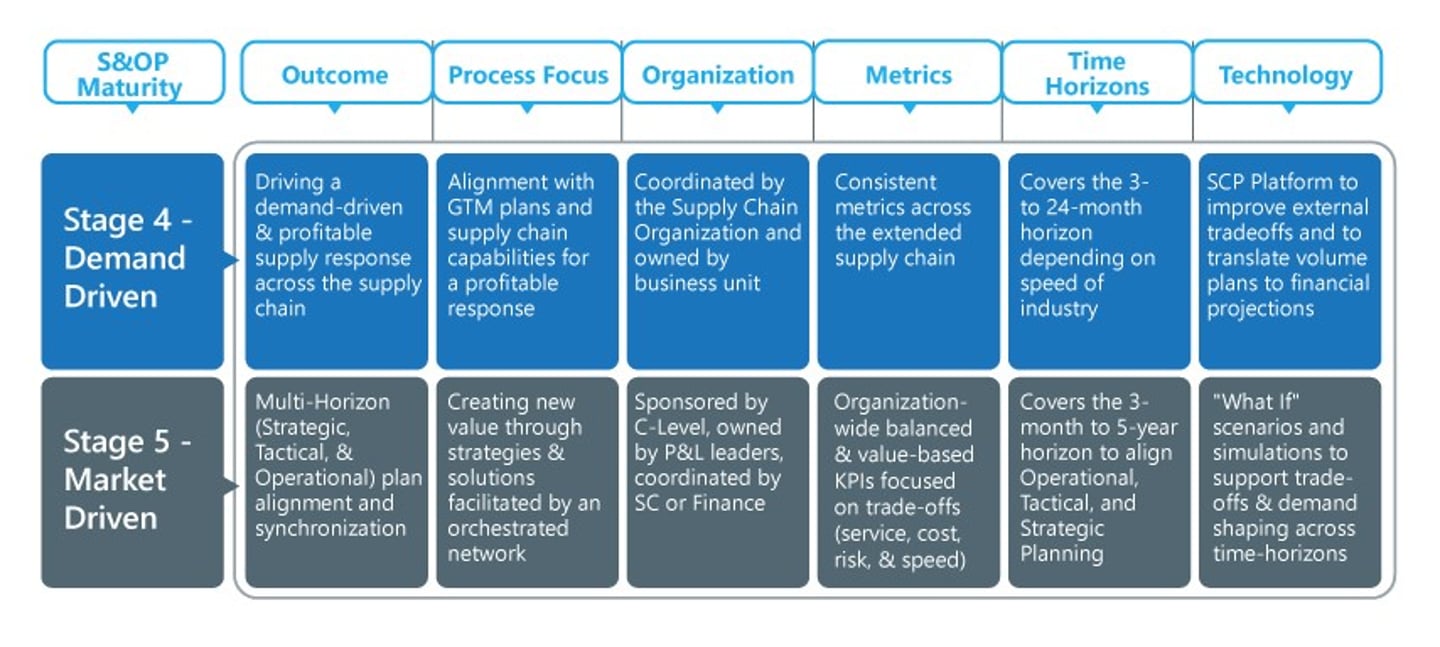Climbing the Sales & Operations Maturity Ladder, Stage 5
Does this sound familiar to you? Many companies today have multiple disconnected planning processes that are managed by different people, use various data sets and assumptions, and are facilitated through several unique systems. This common situation leads to multiple, non-integrated planning processes that develop different plans and cause miscommunication, misalignment, extra work and missed opportunities.
Instead, you need strategic plans that can incorporate into an aggregate S&OP plan and reflect the latest supply chain network and operational data to create a digital twin. This allows you to anticipate risks and seize new opportunities, lower costs while driving profitable growth.
In this third and final article in our series, Climbing the Sales and Operations Maturity Ladder, we explore the characteristics of S&OP process maturity and recommend actions you can take today to move to higher levels of S&OP capability.
To build a resilient enterprise with a robust and repeatable S&OP process you need a single, integrated phased planning approach that unites short-, medium-, and long-term planning under one process that is supported by one system. To paraphrase the central plot of J. R. R. Tolkien's The Lord of the Rings, “One system to rule them all, one system to coordinate them. One system to synchronize them all and in visibility bind them”. Advanced S&OP, sometimes referred to as Integrated Business Planning, drives better planning practices and closer collaboration among planning teams—especially by creating alignment and synchronization between multi-horizon planning activities.
IBP unites volumetric and financial information into one flexible planning and decision support process over operational, tactical, and strategic planning horizons. Everyone gets reliable answers faster. Forecasts and capacity plans become more accurate and synchronized.
Alerts highlight plan deviations. Lag time drops. Trust improves. Excess inventory and obsolescence drop as your long-term planning is done with confidence. This is a win-win for everyone.
Another key to reaching higher levels of S&OP Maturity is consistently getting all key company functions to the table and holding efficient and effective executive S&OP planning meetings.
- Try to make executive S&OP meetings part of the agenda or adjacent to already existing meetings to minimize conflicts across time zones and potential travel.
- Ensure reports and metrics are at the right level for the audience. This usually means that data is compatible with what executives are used to reviewing at a P&L level and represented at the business unit, geography, or company level.
- Only discuss opportunities and risks that are at a significant level, such as big dollar items, significant labor decisions, and important decisions involving partners. Define what should be considered significant.
- Provide a good mix of numerical and graphical balanced and aligned volumetric and financial views. More advanced processes may be able to adjust these views on the fly as what-if questions are asked.
- Prepare and facilitate well to ensure all critical decisions are made and a consensus plan is approved before the end of the meeting if possible.
Reaching the highest levels of S&OP Maturity requires an organizational-wide, multi-horizon, outside-in focus to create new customer and company value utilizing advanced analytics like “what-if” scenarios, simulations, and demand shaping.
Below, are the characteristics of stage 4 and stage 5 S&OP capabilities across six dimensions: outcome, process focus, organization, metrics, time horizon and technology.
Mature Sales & Operations Planning enables volumetric and financial multi-horizon planning that combines information from sales, marketing, production, procurement, distribution, and finance to create a powerful decision center for all stakeholders. By removing organizational and technology barriers and aligning and synchronizing plans, advanced S&OP ensures your business plans are rooted in feasible supply chain network capabilities, with resources and investments deployed where they are most effective in achieving business goals.
And possibly even more important today, having an end-to-end view of the business enables greater agility so you can respond faster and make better decisions when faced with supply chain disruptions and opportunities.
Hank Canitz is product marketing director at Logility. Hank brings more than 25 years of experience building high performance supply chains. This experience includes evaluating, selecting, implementing, using and marketing supply chain technology. Hank’s graduate degree in SCM from Michigan State, numerous SCM certifications, diverse experience as a supply chain practitioner and experience in senior marketing roles with leading supply chain solution providers helps him to bring a unique perspective on supply chain best practices and supporting technology to the Logility Blog.







